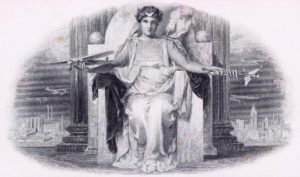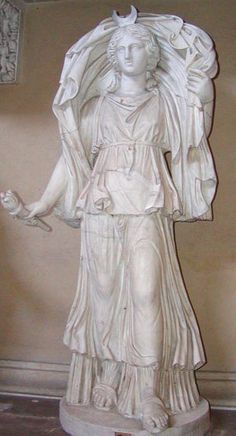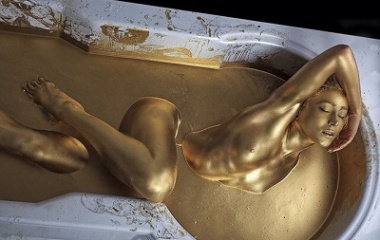- Pronunciation: THEE-ah
- Origin: Greek
- Role: Titan goddess
- Symbols: Light
- Husband: Hyperion
- Children: Helios, Selene, Eos
- Other Names: Euryphaessa, Thia, Theia
Who Is Theia?
Theia was a Titan goddess, more commonly referred to as the goddess of shining elements. She was associated with shining metals, shining jewels or shining light. She was also known as the goddess of sight and the Greeks believed her eyes were beams of light, helping them see with their own mortal eyes. She was one of the twelve Titans and like her famous sisters Phoebe and Themis, she was also associated with the gift of prophecy and had a shrine in Thessaly.
Origins
Theia was one of the original Titans, who were large and powerful beings that are typically found to be the foundation of Greek mythology stories. Born to Uranus and Gaia, the siblings ruled the world until being overthrown by Zeus and his siblings, the Olympian gods. Theia’s siblings include Oceanus, Coeus, Cronus, Crius, Hyperion, Iapetus, Tethys, Themis, Phoebe, Mnemosyne and Rhea.
Legends and Stories
Theia is not directly mentioned in many Greek myths but it is assumed that she played a supporting role in many of them as Hyperion’s wife.
The Gift of Sight
Hyperion and his brothers, also brothers of Theia, were seen as the gods responsible for the creation of man. Each god gave mankind one of their senses. It is assumed that Hyperion was the god who enabled men to see, for his name translates to “he who watches from above”. Another supporting clue to this assumption is that Theia, the goddess of sight, was part of the reason Hyperion gave mankind his chosen gift.
Chosen for the Throne
Some mythology experts don’t agree with this story but it’s worth mentioning regarding the fate of Theia and her children. Uranus, her and her husband’s father, had chosen them to be the pair that would take over his throne when the time came. But Cronus, Theia and Hyperion’s brother, was jealous of his father’s choice and set out to find a way to make the throne his. He kidnapped Helios, Selene and Eos and before their parents knew that their children were missing, Cronus drowned them in the River Eridanus. He then told their parents that Uranus had committed the murders because he feared them. Hyperion believed him and vowed to seek revenge.
Family
Theia was married to her brother Hyperion. He was the Titan god of light, which may have been responsible for the rolls of their three children.
Helios
Helios was the Titan god of sun. He lived in a golden palace on the far east corner of the earth. He would travel from the east to the west in his golden chariot during the day, which was pulled across the sky by four winged horses. He would wear a radiant circle as he travelled across the sky. During the evening hours, he would descend into a golden cup and be carried back to his golden palace until doing the same the next day. His daily routine was described by Homer as,
“Driving his horses, he shines upon men and immortal gods. His eyes gaze piercingly out of his golden helmet, bright rays beam brilliantly from his temples, and the shining hair of his head graciously frames his far-away face. A rich, fine spun garment gleams on his body and flutters in the winds, and stallions carry him.”
When Apollo was born, Helios passed on his responsibilities to him. However, he was still the personification of the sun.
Selene
Theia’s daughter Selene was known as the Titan goddess of moon. She would also ride a chariot through the sky, pulled by winged horses, while wearing a golden cloak. She would eventually be replaced by Artemis.
She fell in love with a mortal named Endymion. Zeus eventually granted him the gift of immortality and eternal youth. Together, Endymion and Selene had 50 daughters, known as the Menae. They represent the 50-month lunar cycle of each Olympiad. However, he fell into a state of eternal slumber by Mount Latmos. Selene would come and visit every night.
Selene is also associated with lunar elements, such as lunacy, the calendar months and the tides of the ocean. She had a child with Zeus named Pandeia, the goddess of dew.
Eos
Eos was known as the goddess of the dawn. She would rise each day before morning from the edge of Oceanus. Her golden rays would overcome the morning mist and remaining shadows of the night. Some myths say that she was carried across the sky in a gold chariot with winged horses while other say that she herself had white wings that enabled her to fly.
She was fittingly married to her cousin Astraeus, the god of dusk. Aphrodite had set a curse upon her though and she found herself uncontrollably attracted to mortal men. She eventually fell in love with the prince of Troy, Tithonus. Zeus also granted the prince with immortality but Eos forgot to ask for the god to grand her lover eternal youth and he continued to age. According to some sources, he eventually became the first grasshopper. But before this, Eos and Tithonos had two sons. The first was Memnon who became king of Ethiopia and the second was Emathion who became the king of Arabia.
Appearance
Theia is always pictured as a strikingly beautiful woman. She typically has long hair and flowing clothing that helps to show the light around her. It’s not uncommon for her to be either directing light towards the earth or moon or even holding light in her hands. In other artistic representations, she is shown with child, as she was the mother of the Sun, Moon and Dawn.
Symbology
The main symbol of Theia is her eyes. Because the Greek’s believed that her eyes emitted a beam that allowed them to see, her eyes were the most important to them. In artistic representations of the goddess, she is often shown with the sun or moon but these would be better classified as symbols of her children.








